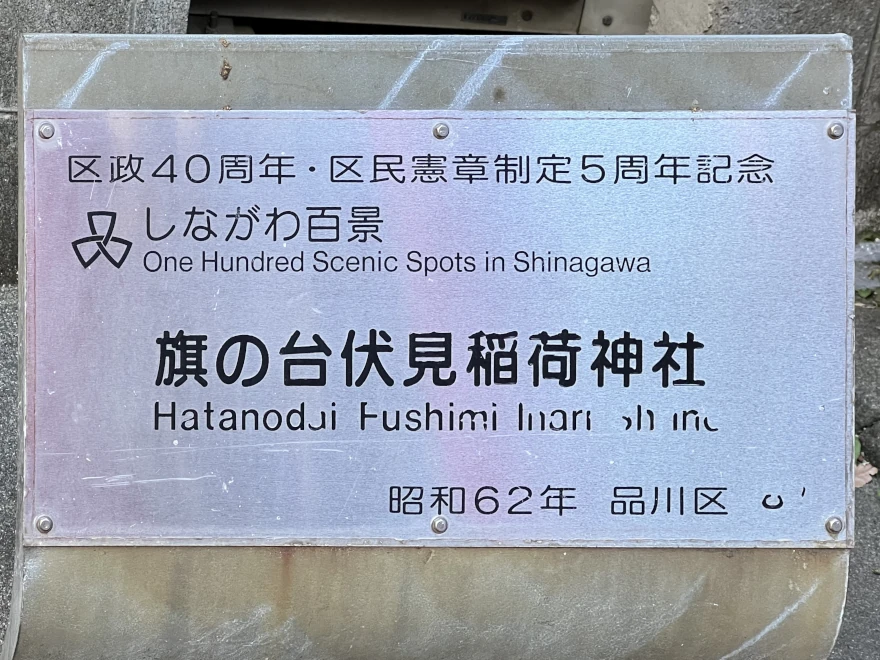Hatanodai Fushimi Inari Shrine – A Hidden Grove of Red Torii
✨ A Peaceful Shrine in the City
Hatanodai Fushimi Inari Shrine (旗の台伏見稲荷神社) is a small, serene shrine tucked between homes and apartments in Shinagawa’s Hatanodai district. It’s dedicated to Ukanomitama-no-kami, the deity of grain and prosperity. This branch of Kyoto’s famous Fushimi Inari Shrine has quietly protected the neighborhood since its founding in 1926 (Taisho 15).
🦊 A Place of Quiet Devotion
Local believers who cherished the Inari tradition built the shrine. Soon after, it became a center of community faith. Two red torii gates mark the entrance. Beyond them lies a short path, lined with tall ginkgo and Japanese chinquapin trees. Walking through feels like stepping into another world. The fox statues—Inari’s sacred messengers—stand as guardians of the main hall.
🔥 Protected in Wartime
During the Pacific War, 120 local men came to this shrine to pray before heading to the front lines. Amazingly, they all returned safely. Even more astonishing, this area of Hatanodai survived wartime bombings—despite its location near major train lines. Many believe the shrine’s power helped protect the community.
🎎 Traditions That Continue
A small sign at the site shares the shrine’s early history. Back then, Hatanodai was still a wooded area on the edge of the city. Despite Tokyo’s rapid change, the shrine has stayed a peaceful refuge. Each February, on the second Sunday, the shrine hosts its Hatsu-uma Festival. Locals gather to pound mochi—over 70 kilograms of it! Commemorative flags go up along the shopping street to celebrate the event.
⛩ Shrine Details
- Deity: Ukanomitama-no-kami (宇迦之御魂神)
- Origin: Branch of Kyoto Fushimi Inari Taisha
- Founded: 1926 (Taisho 15)
- Features: Red torii, guardian foxes, old trees
- Annual Events: Hatsu-uma Festival, wartime remembrance
Though compact, this shrine is beloved for its spiritual calm and surprising longevity. Local stories and seasonal rituals continue to tie it closely to Hatanodai’s identity and resilience.
🧭 Visitor Information
Address: 5-15-2 Hatanodai, Shinagawa-ku, Tokyo 142-0064
Access: 4-minute walk from Hatanodai Station (South Exit)
Best season: Autumn (foliage), Hatsu-uma Festival in February
Admission: Free
Official Info: None
Where is it?
| what3words | ///dorm.recorder.exhale |
| latitude longitude | 35.6046018, 139.696868 |
| Nearest station(s) | Hatanodai Station (Oimachi and Ikegami Lines) |
| Nearest public conveniences | Nearby station or local café |
Show me a sign.

Kanji hanging in there.
Withervee says…
This is one of those places you stumble across and feel lucky for it, or might not stumble across at all. In my case, spend 10 minutes walking round in circles thinking, “maybe, it’s been turned into a house?” Hatanodai Fushimi Inari isn’t large, but it radiates protection, history, and a peculiar peacefulness just steps away from the busy road – Nakahara Kaido.
Site Character
- Lifestyle 生活 (Seikatsu): ✔️
- Historical Significance 歴史 (Rekishi): ✔️
- Atmosphere/Natural Features 風土 (Fūdo): ✔️
Who in their right mind would vote for this?
- Local Shintō devotees
- Fushimi Inari fans
- Peace-seekers
- Photographers who love torii
- People who like tranquility
Further reading
Area information: Hatanodai Inari Street Shopping Association
While you’re there…
Grab a croquette or onigiri from the local shops around Hatanodai Station and take a stroll to Hatanodai Park to change diapers and breastfeed your child. Or take a look at some circles on the nearby Kanariya-zaka hill.
Previous
81: Horenji Temple

